
Petersburg is an independent city in the Commonwealth of Virginia in the United States. As of the 2020 census, the population was 33,458. The Bureau of Economic Analysis combines Petersburg with Dinwiddie County for statistical purposes. The city is 21 miles (34 km) south of the commonwealth (state) capital city of Richmond.

The siege of Yorktown, also known as the Battle of Yorktown, the surrender at Yorktown, or the German battle because of the presence of Germans in all three armies, began September 28, 1781 and ended on October 19, 1781, in Yorktown, Virginia. It was a decisive victory by a combined force of the American Continental Army troops led by General George Washington with support from Marquis de Lafayette and French Army troops led by Comte de Rochambeau over the British Army commanded by British Lieutenant General Charles Cornwallis.
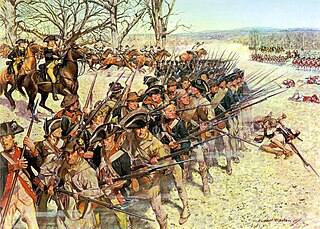
The Battle of Guilford Court House was on March 15, 1781, during the American Revolutionary War, at a site that is now in Greensboro, the seat of Guilford County, North Carolina. A 2,100-man British force under the command of Lieutenant General Charles Cornwallis defeated Major General Nathanael Greene's 4,500 Americans. The British Army, however, suffered considerable casualties.
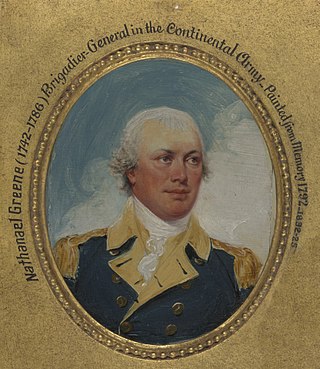
Major-General Nathanael Greene was an American military officer and planter who served in the Continental Army during the Revolutionary War. He emerged from the war with a reputation as one of George Washington's most talented and dependable officers, and is known for his successful command in the Southern theater of the conflict.
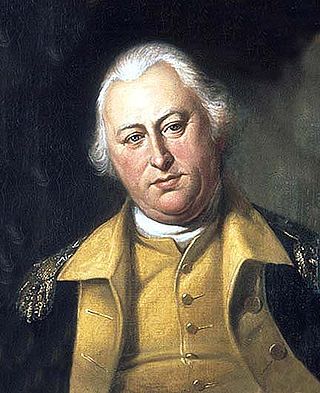
Benjamin Lincoln was an American army officer. He served as a major general in the Continental Army during the American Revolutionary War. Lincoln was involved in three major surrenders during the war: his participation in the Battles of Saratoga contributed to John Burgoyne's surrender of a British army, he oversaw the largest American surrender of the war at the 1780 siege of Charleston, and, as George Washington's second in command, he formally accepted the British surrender at Yorktown.
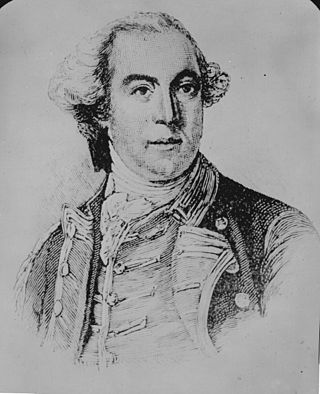
William Phillips was a renowned artilleryman and general officer in the British Army who served as a major-general in the American War of Independence.
City Point was a town in Prince George County, Virginia, that was annexed by the independent city of Hopewell in 1923. It served as headquarters of the Union Army during the siege of Petersburg during the American Civil War.
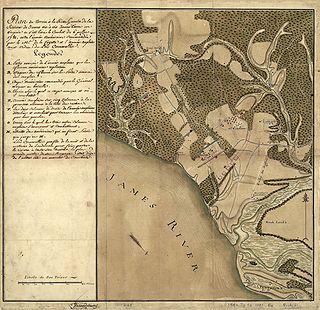
The Battle of Green Spring took place near Green Spring Plantation in James City County, Virginia during the American Revolutionary War. On July 6, 1781 United States Brigadier General "Mad" Anthony Wayne, leading the advance forces of the Marquis de Lafayette, was ambushed near the plantation by the British army of Earl Charles Cornwallis in the last major land battle of the Virginia campaign prior to the Siege of Yorktown.
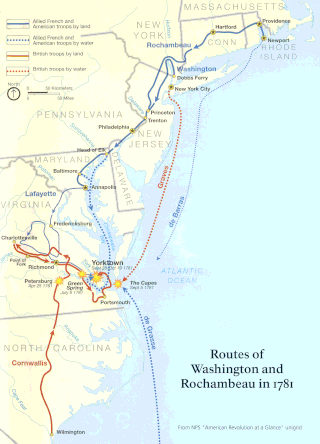
The Yorktown campaign, also known as the Virginia campaign, was a series of military maneuvers and battles during the American Revolutionary War that culminated in the Siege of Yorktown in October 1781. The result of the campaign was the surrender of the British Army force of General Charles Earl Cornwallis, an event that led directly to the beginning of serious peace negotiations and the eventual end of the war. The campaign was marked by disagreements, indecision, and miscommunication on the part of British leaders, and by a remarkable set of cooperative decisions, at times in violation of orders, by the French and Americans.

The southern theater of the American Revolutionary War was the central theater of military operations in the second half of the American Revolutionary War, 1778–1781. It encompassed engagements primarily in Virginia, Georgia and South Carolina. Tactics consisted of both strategic battles and guerrilla warfare.

The siege of Yorktown was the culminating act of the Yorktown campaign, a series of military operations occupying much of 1781 during the American Revolutionary War. The siege was a decisive Franco-American victory: after the surrender of British Lt. Gen. Charles, Earl Cornwallis on October 17, the government of Lord North fell, and its replacement entered into peace negotiations that resulted in British recognition of American independence with the 1783 Treaty of Paris.
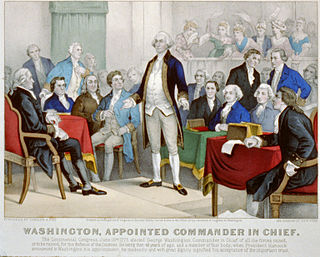
George Washington commanded the Continental Army in the American Revolutionary War (1775–1783). After serving as President of the United States, he briefly was in charge of a new army in 1798.

The military career of George Washington spanned over forty years of service (1752–1799). Washington's service can be broken into three periods, French and Indian War, American Revolutionary War, and the Quasi-War with France, with service in three different armed forces.

The Battle of Spencer's Ordinary was an inconclusive skirmish that took place on 26 June 1781, late in the American Revolutionary War. British forces under Lieutenant Colonel John Graves Simcoe and American forces under Colonel Richard Butler, light detachments from the armies of General Lord Cornwallis and the Marquis de Lafayette respectively, clashed near a tavern at a road intersection not far from Williamsburg, Virginia.

Charles, Earl Cornwallis (1738–1805) was a military officer who served in the British Army during the American War of Independence. He is best known for surrendering his army after the 1781 siege of Yorktown, an act that ended major hostilities in North America and led directly to peace negotiations and the eventual end of the war.

The military career of Benedict Arnold in 1781 consisted of service in the British Army. Arnold had changed sides in September 1780, after his plot was exposed to surrender the key Continental Army outpost at West Point. He spent the rest of 1780 recruiting Loyalists for a new regiment called the American Legion. Arnold was then sent to Virginia with 1,600 men in late December by General Sir Henry Clinton, with instructions to raid Richmond and then establish a strong fortification at Portsmouth.

The history of Virginia in the American Revolution begins with the role the Colony of Virginia played in early dissent against the British government and culminates with the defeat of General Cornwallis by the allied forces at the Siege of Yorktown in 1781, an event signaled the effective military end to the conflict. Numerous Virginians played key roles in the Revolution, including George Washington, Patrick Henry, and Thomas Jefferson.
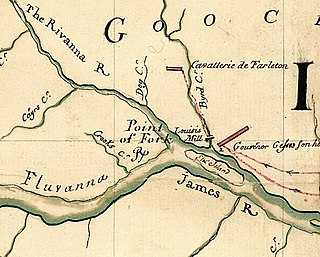
Point of Fork Arsenal was an arsenal established in the 18th century located near what is now Columbia, Virginia, United States. It was raided and destroyed on June 5, 1781, by Col. John Graves Simcoe of the Queen's Rangers. It was rebuilt and used for the manufacture and repair of arms and supplied material to combat the Whiskey Rebellion and to aid the Battle of Fallen Timbers. The arsenal remained in service until 1801, when it was abandoned in favor of a more centralized arsenal at Richmond, the Virginia Manufactory of Arms.
The history of Petersburg, Virginia, United States as a modern settlement begins in the 17th century when it was first settled. The city was incorporated in 1748. It was occupied by the British during the American Revolutionary War, and Major-General William Phillips died of fever at Blandford during bombardment from the Marquis de Lafayette's positions north of the river. After the war, it became a destination for many free blacks in Virginia, as well as a growing hub for railroads. By 1860, it was the second largest city in Virginia. For nine months in 1864 and 1865 it was the subject of the Siege of Petersburg; the fall of the city unleashed a chain of events over the following two weeks that resulted in the end of the American Civil War. After the war, it again flourished as a destination for Freedmen. Petersburg was a notable focal point in the organization of the Civil Rights Movement in the mid-20th century. In the late 20th century, the city suffered significant economic decline.

The action at Osborne's, Virginia was a minor naval–land engagement on April 27, 1781, in the James River during the American Revolutionary War. The battle resulted in the near-complete destruction of the Virginia State Navy as well as a large stockpile of Virginian tobacco.






















